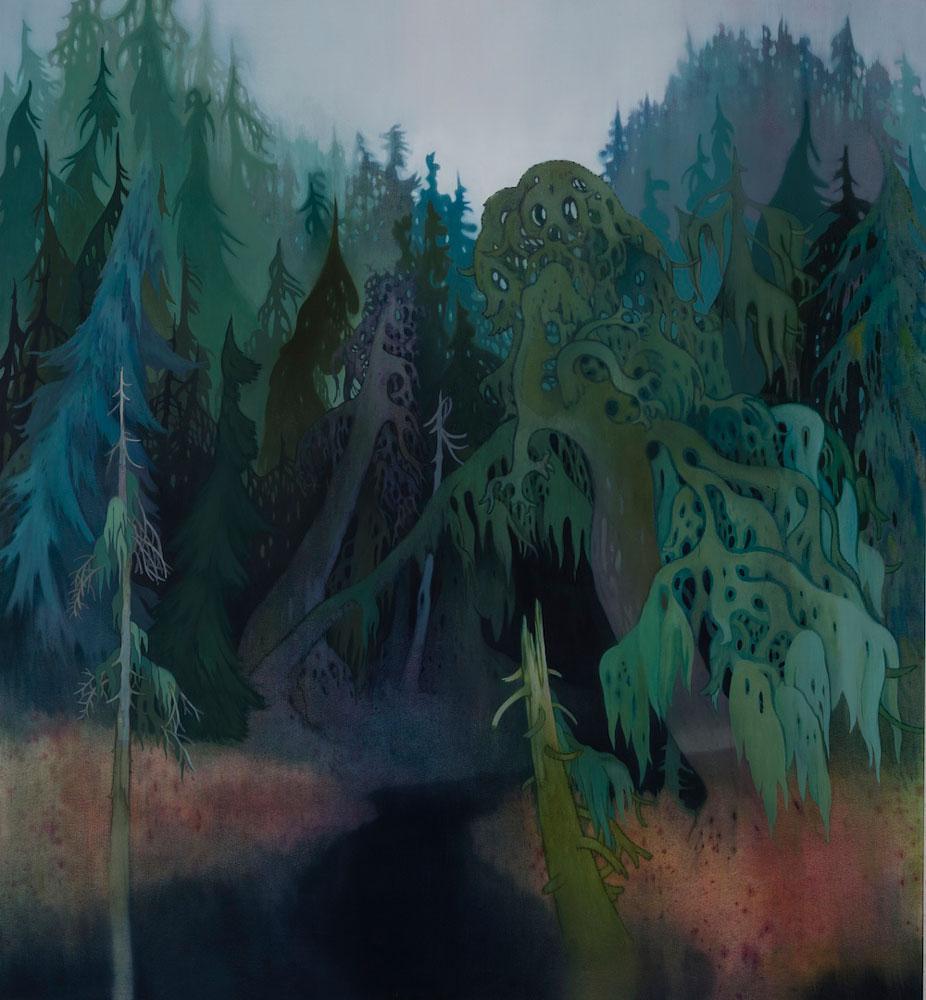There’s something about Parisian Laundry. The solidity of its beams, the history embedded in its pillars, and the incredible natural light and vast openness of its main floors would predispose even the most impassive art seer to be moved to inspiration.
Last time I visited, the main space on the first floor, sun-kissed from all sides, greeted in its gorgeousness 12 paintings by Rick Leong, hung on three walls along the edge of the room. A better setting couldn’t have been imagined; Leong’s works are ethereal, foggy visions of fairy-tale forests and nature gone unthreateningly wild. Peopled with all types of birds, rainbows, creeping anthropomorphic trees and sparkling pebbles—the stuff not only of dreams, but also of Japanese animation for children—his works seem like doorways into the minds of so many mushroom-tripping teenagers.
While standing in front of each painting, I swear I could hear the tweets of birds in the distance; the visceral abandonment into the fantasy was just so there. But there was also a bit of a sense of the unbearable lightness of being. Something about how idyllic the experience was made it seem situational in an exclusive sense; when I left the spectre of the paintings, walked behind one of the walls and looked out the window for a while, the overwhelming prettiness of the exhibition floated from my mind—poof!—like cotton candy once melted on the tongue.
The birds I’d heard were explained when I descended into the bunker, Parisian Laundry’s windowless stone basement.
In the first room was a video by Dean Baldwin: Lime Eyes, from 2012. Filmed in the Cordillera de Tilarán mountain range in Central America, inside a Costa Rican nature reserve, the six-minute video combines environmental sounds from the rainforest—calls by red-billed toucans and mantled howler monkeys, among many other residents—with the silliest of human sounds. Jungle scenes, perfectly contrasting with Leong’s images of wilderness given their very real, damp, muddy imperfection, are interrupted by shots of faces: two papaya slices for eyes and a banana for a mouth pinned to a tree-trunk body, for example.
Lime Eyes is full of these characters made with found foods and objects, and most times, a goofball sound accompanies the shot: a guttural expression of surprise (“hunh!”), maybe, or a quizzical sound of reflection (“hmmm”). It’s the silliest thing ever, and somehow it was the most hilarious experience I’d had all week.
After watching Baldwin’s second video, 2008’s Not Still Short Life, in which Baldwin filmed the slow creation and desiccation of a cornucopia still life featuring a decadent plenitude of breads, fruit, cheeses, liquors and other items laid on a green-and-white-checkered tabletop, I went back up and lived among the Leongs again.
My perception of Leong’s work was completely different. Baldwin, with his messy, visceral embrace of natural splendour and humouristically simplified themes—waste is bad, trees are people too—gave roots to the vaporous, otherworldy exhibition upstairs in a way that revealed its own undertones. Suddenly I was seeing a new depth in Leong’s paintings; beyond the seduction and the prettiness, there’s a haunting dimension. The black wash that engulfs half of the 2011 painting titled Nightfall, for example, didn’t seem like innocent somnolence this time around. It seemed mysterious and malevolent—in a very good way.









